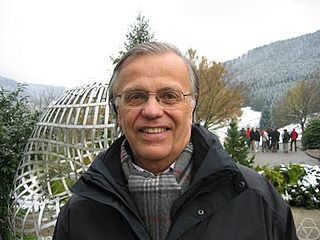In cryptography, key size, key length, or key space refer to the number of bits in a key used by a cryptographic algorithm.
Elliptic-curve cryptography (ECC) is an approach to public-key cryptography based on the algebraic structure of elliptic curves over finite fields. ECC allows smaller keys compared to non-EC cryptography to provide equivalent security.

Public-key cryptography, or asymmetric cryptography, is the field of cryptographic systems that use pairs of related keys. Each key pair consists of a public key and a corresponding private key. Key pairs are generated with cryptographic algorithms based on mathematical problems termed one-way functions. Security of public-key cryptography depends on keeping the private key secret; the public key can be openly distributed without compromising security.
Articles related to cryptography include:

RSA Security LLC, formerly RSA Security, Inc. and doing business as RSA, is an American computer and network security company with a focus on encryption and encryption standards. RSA was named after the initials of its co-founders, Ron Rivest, Adi Shamir and Leonard Adleman, after whom the RSA public key cryptography algorithm was also named. Among its products is the SecurID authentication token. The BSAFE cryptography libraries were also initially owned by RSA. RSA is known for incorporating backdoors developed by the NSA in its products. It also organizes the annual RSA Conference, an information security conference.
In cryptography, the Elliptic Curve Digital Signature Algorithm (ECDSA) offers a variant of the Digital Signature Algorithm (DSA) which uses elliptic-curve cryptography.
NTRU is an open-source public-key cryptosystem that uses lattice-based cryptography to encrypt and decrypt data. It consists of two algorithms: NTRUEncrypt, which is used for encryption, and NTRUSign, which is used for digital signatures. Unlike other popular public-key cryptosystems, it is resistant to attacks using Shor's algorithm. NTRUEncrypt was patented, but it was placed in the public domain in 2017. NTRUSign is patented, but it can be used by software under the GPL.
Hyperelliptic curve cryptography is similar to elliptic curve cryptography (ECC) insofar as the Jacobian of a hyperelliptic curve is an abelian group in which to do arithmetic, just as we use the group of points on an elliptic curve in ECC.
Scott A. Vanstone was a mathematician and cryptographer in the University of Waterloo Faculty of Mathematics. He was a member of the school's Centre for Applied Cryptographic Research, and was also a founder of the cybersecurity company Certicom. He received his PhD in 1974 at the University of Waterloo, and for about a decade worked principally in combinatorial design theory, finite geometry, and finite fields. In the 1980s he started working in cryptography. An early result of Vanstone was an improved algorithm for computing discrete logarithms in binary fields, which inspired Don Coppersmith to develop his famous exp(n^{1/3+ε}) algorithm.
The Centre for Applied Cryptographic Research (CACR) is a group of industrial representatives, professors, and students at the University of Waterloo in Waterloo, Ontario, Canada who work and do research in the field of cryptography.

Gerhard Frey is a German mathematician, known for his work in number theory. Following an original idea of Hellegouarch, he developed the notion of Frey–Hellegouarch curves, a construction of an elliptic curve from a purported solution to the Fermat equation, that is central to Wiles's proof of Fermat's Last Theorem.
In cryptography, the Standards for Efficient Cryptography Group (SECG) is an international consortium founded by Certicom in 1998. The group exists to develop commercial standards for efficient and interoperable cryptography based on elliptic curve cryptography (ECC).
NSA Suite B Cryptography was a set of cryptographic algorithms promulgated by the National Security Agency as part of its Cryptographic Modernization Program. It was to serve as an interoperable cryptographic base for both unclassified information and most classified information.
IEEE P1363 is an Institute of Electrical and Electronics Engineers (IEEE) standardization project for public-key cryptography. It includes specifications for:
Alfred Menezes is co-author of several books on cryptography, including the Handbook of Applied Cryptography, and is a professor of mathematics at the University of Waterloo in Canada.
In cryptography, implicit certificates are a variant of public key certificate. A subject's public key is reconstructed from the data in an implicit certificate, and is then said to be "implicitly" verified. Tampering with the certificate will result in the reconstructed public key being invalid, in the sense that it is infeasible to find the matching private key value, as would be required to make use of the tampered certificate.
Dual_EC_DRBG is an algorithm that was presented as a cryptographically secure pseudorandom number generator (CSPRNG) using methods in elliptic curve cryptography. Despite wide public criticism, including the public identification of the possibility that the National Security Agency put a backdoor into a recommended implementation, it was for seven years one of four CSPRNGs standardized in NIST SP 800-90A as originally published circa June 2006, until it was withdrawn in 2014.
The following outline is provided as an overview of and topical guide to cryptography:
The Commercial National Security Algorithm Suite (CNSA) is a set of cryptographic algorithms promulgated by the National Security Agency as a replacement for NSA Suite B Cryptography algorithms. It serves as the cryptographic base to protect US National Security Systems information up to the top secret level, while the NSA plans for a transition to quantum-resistant cryptography.


